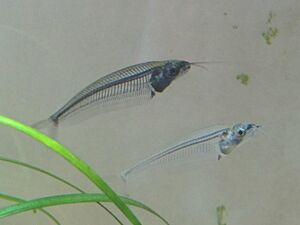Kryptopterus bicirrhis facts for kids
Quick facts for kids Kryptopterus bicirrhis |
|
|---|---|
 |
|
| Conservation status | |
| Scientific classification |
The Kryptopterus bicirrhis, often called the glass catfish, is a type of Asian glass catfish. It belongs to the Kryptopterus group of fish. For a long time, people thought this species included a smaller fish called Kryptopterus vitreolus, also known as the "ghost catfish."
Even today, the name K. bicirrhis and "glass catfish" are often used in pet stores to mean the smaller K. vitreolus. This is because the true K. bicirrhis is larger and a bit more aggressive. It has not been sold as much for aquariums.
In western Borneo, where both K. minor and K. bicirrhis live, locals call both species lais tipis. If they want to tell them apart, they call K. minor lais limpok. In Cambodia, this fish is known as trey kes prak (Khmer: ត្រីកេះប្រាក់). It is used to make a fermented fish paste called prahok.
Contents
What Does the Glass Catfish Look Like?
The real K. bicirrhis is easy to tell apart from K. vitreolus. It grows much bigger, up to about 15 cm (5.9 in) long. Most of its body is not completely clear or see-through. Only the area around its head is clearly transparent. The rest of its body is mostly solid and light grey.
When light hits the glass catfish, it can look shiny and colorful, like a rainbow. This is called iridescence. When the fish dies, its body turns a milky white color. It has two long whiskers, called barbels, which it uses to find food. These whiskers can be as long as the front part of its body. Its back fin is very small, like a tiny triangle. Its side fins are longer than its head.
Where Does the Glass Catfish Live?
The Kryptopterus bicirrhis lives in parts of Borneo, Sumatra, the Malay Peninsula, and the Chao Phraya and Mekong drainage basins.
This freshwater catfish prefers large rivers with cloudy water. They usually live close to the shore where the water flows quickly. It seems to like water that has a lot of peat in it. The temperature of the water it lives in is usually around 21 to 26 °C (70 to 79 °F). The glass catfish is a daytime predator. This means it hunts for food during the day. It mainly eats water bugs and sometimes small fish.
How Glass Catfish Sense Magnetic Fields
Kryptopterus bicirrhis are very good at sensing magnetic fields. They have special organs that can detect electricity. Usually, fish that can sense magnetic fields use this ability to help them migrate, or travel long distances. However, glass catfish do not migrate.
These fish will swim away from any magnetic field that is stronger than a certain level (20 μT or microtesla). This happens because of a special gene they have called EPG (electromagnetic perceptive gene). This gene makes the amount of calcium in their cells increase when the magnetic field is stronger. Scientists are studying this. In the future, this research might help us learn how to control cell activity without touching the cells directly. This could lead to new ways to do brain surgeries that are less invasive.
See also
- List of freshwater aquarium fish species


